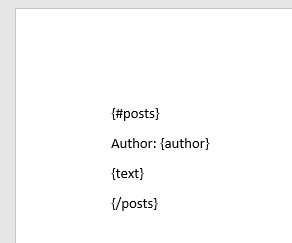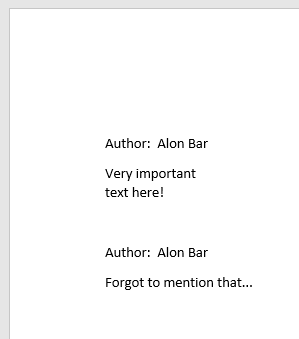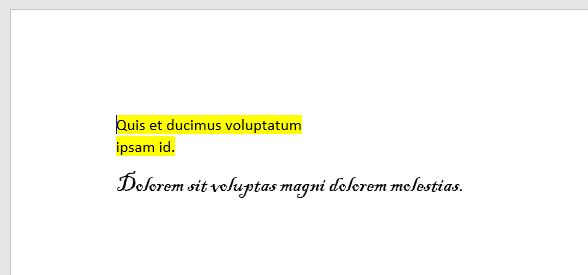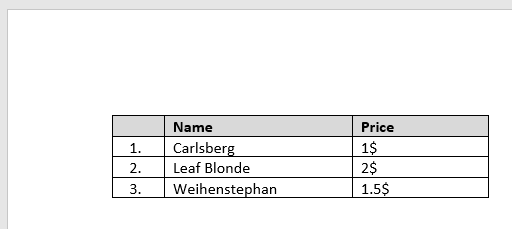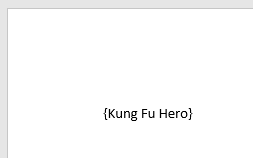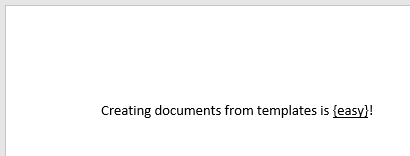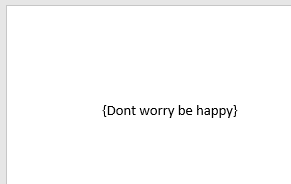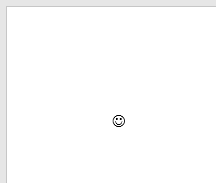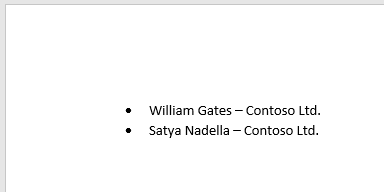Generate docx documents from templates, in Node or in the browser.
- Node Example
- Browser Example
- Live Demo
- Plugins
- Extensions
- Scope resolution
- Advanced API
- Supported Binary Formats
- Philosophy
- Prior art and motivation
- Changelog
import * as fs from 'fs';
import { TemplateHandler } from 'easy-template-x';
// 1. read template file
const templateFile = fs.readFileSync('myTemplate.docx');
// 2. process the template
const data = {
posts: [
{ author: 'Alon Bar', text: 'Very important\ntext here!' },
{ author: 'Alon Bar', text: 'Forgot to mention that...' }
]
};
const handler = new TemplateHandler();
const doc = await handler.process(templateFile, data);
// 3. save output
fs.writeFileSync('myTemplate - output.docx', doc);Input:
Output:
The following example produces the same output while running in the browser. Notice that the actual template processing (step 2) is exactly the same as in the previous Node example.
import { TemplateHandler } from 'easy-template-x';
// 1. read template file
// (in this example we're loading the template by performing
// an AJAX call using the fetch API, another common way to
// get your hand on a Blob is to use an HTML File Input)
const response = await fetch('http://somewhere.com/myTemplate.docx');
const templateFile = await response.blob();
// 2. process the template
const data = {
posts: [
{ author: 'Alon Bar', text: 'Very important\ntext here!' },
{ author: 'Alon Bar', text: 'Forgot to mention that...' }
]
};
const handler = new TemplateHandler();
const doc = await handler.process(templateFile, data);
// 3. save output
saveFile('myTemplate - output.docx', doc);
function saveFile(filename, blob) {
// see: https://stackoverflow.com/questions/19327749/javascript-blob-filename-without-link
// get downloadable url from the blob
const blobUrl = URL.createObjectURL(blob);
// create temp link element
let link = document.createElement("a");
link.download = filename;
link.href = blobUrl;
// use the link to invoke a download
document.body.appendChild(link);
link.click();
// remove the link
setTimeout(() => {
link.remove();
window.URL.revokeObjectURL(blobUrl);
link = null;
}, 0);
}Checkout this live demo on CodeSandbox 😎
easy-template-x uses a plugin model to support it's various template manipulation capabilities. There are some built-in plugins and you can also write your own custom plugins if required.
These are the plugins that comes bundled with easy-template-x:
- Simple text replacement plugin.
- Loop plugin for iterating text, table rows and list rows.
- Image plugin for embedding images.
- Link plugin for hyperlinks creation.
- Raw xml plugin for custom xml insertion.
The most basic plugin. Replaces a single tag with custom text. Preserves the original text style.
Input template:
Input data:
{
"First Tag": "Quis et ducimus voluptatum\nipsam id.",
"Second Tag": "Dolorem sit voluptas magni dolorem molestias."
}Output document:
Iterates text, table rows and lists.
Requires an opening tag that starts with # and a closing tag that has the same
name and starts with /.
Input template:
Input data:
{
"Beers": [
{ "Brand": "Carlsberg", "Price": 1 },
{ "Brand": "Leaf Blonde", "Price": 2 },
{ "Brand": "Weihenstephan", "Price": 1.5 }
]
}Output document:
Embed images into the document.
Input template:
Input data:
{
"Kung Fu Hero": {
_type: "image",
source: fs.readFileSync("hero.png"),
format: MimeType.Png,
width: 200,
height: 200
}
}Output document:
Inserts hyperlinks into the document.
Like text tags link tags also preserve their original style.
Input template:
Input data:
{
"easy": {
_type: 'link',
text: 'super easy', // optional - if not specified the `target` property will be used
target: 'https://github.com/alonrbar/easy-template-x'
}
}Output document:
Add custom xml into the document to be interpreted by Word.
Tip:
You can add page breaks using this plugin and the following xml markup:
<w:br w:type="page"/>
Input template:
Input data:
{
"Dont worry be happy": {
_type: 'rawXml',
xml: '<w:sym w:font="Wingdings" w:char="F04A"/>',
replaceParagraph: false, // optional - should the plugin replace an entire paragraph or just the tag itself
}
}Output document:
To write a plugin inherit from the TemplatePlugin class.
The base class provides two methods you can implement and a set of utilities to
make it easier to do the actual xml modification.
To better understand the internal structure of Word documents check out this excellent source.
Example plugin implementation (source):
/**
* A plugin that inserts raw xml to the document.
*/
export class RawXmlPlugin extends TemplatePlugin {
// Declare the unique "content type" this plugin handles
public readonly contentType = 'rawXml';
// Plugin logic goes here:
public simpleTagReplacements(tag: Tag, data: ScopeData): void {
// Tag.xmlTextNode always reference the actual xml text node.
// In MS Word each text node is wrapped by a <w:t> node so we retrieve that.
const wordTextNode = this.utilities.docxParser.containingTextNode(tag.xmlTextNode);
// Get the value to use from the input data.
const value = data.getScopeData() as RawXmlContent;
if (value && typeof value.xml === 'string') {
// If it contains a "xml" string property parse it and insert.
const newNode = this.utilities.xmlParser.parse(value.xml);
XmlNode.insertBefore(newNode, wordTextNode);
}
// Remove the placeholder node.
// We can be sure that only the placeholder is removed since easy-template-x
// makes sure that each tag is isolated into it's own separate <w:t> node.
XmlNode.remove(wordTextNode);
}
}The content type that this plugin expects to see is:
export interface RawXmlContent extends PluginContent {
_type: 'rawXml';
xml: string;
}While most document manipulation can be achieved using plugins, there are some cases where a more powerful tool is required. In order to extend the document manipulation process you can specify extensions that will be run before and/or after the standard template processing.
To write an extension inherit from the TemplateExtension class.
By default no extension is loaded. Extensions and the order they run in are specified via the TemplateHandlerOptions.
const handler = new TemplateHandler({
extensions: {
afterCompilation: [
new DataBindingExtension()
]
}
});The following extensions were developed by the community.
Want to see your extension here? Submit a pull request or open an issue.
The easy-template-x-data-binding extension supports updating custom XML files inside Word documents.
This allows using easy-template-x to automatically fill Word forms that uses content controls.
easy-template-x supports tag data scoping. That is, you can reference
"shallow" data from within deeper in the hierarchy similarly to how you can
reference an outer scope variables from within a function in JavaScript. You can
leverage this property to declare "top level" data (your logo and company name
or some useful xml snippets like page breaks, etc.) to be used anywhere in the
document.
Input template:
(notice that we are using the "Company" tag inside the "Employees" loop)
Input data:
(notice that the "Company" data is declared outside the "Employees" loop, in it's so called "outer scope")
{
"Company": "Contoso Ltd.",
"Employees": [
{ "Surname": "Gates", "Given name": "William" },
{ "Surname": "Nadella", "Given name": "Satya" },
]
}Output document:
You'll usually just use the TemplateHandler as seen in the examples but if you
want to implement a custom plugin or otherwise do some advanced work yourself
checkout the typings file. Do note however that while the
advanced API is mostly documented in the typings file it's still considered an
internal implementation detail and may break between minor versions, use at your
own risk.
The library supports the following binary formats:
- Blob (browser)
- Buffer (node)
- ArrayBuffer (browser and node)
The main principal the package aspire to adhere to is being simple and easy.
It tries to keep it simple and has the following priorities in mind:
- Easy for the end user who writes the templates.
- Easy for the developer who process them using the exposed APIs.
- Easy for the maintainer/contributor who maintain the
easy-template-xpackage itself.
There are already some very good templating libraries out there, most notably these two:
easy-template-x takes great inspiration from both. It aspires to take the best
out of both and to add some good of it's own. Hopefully it will serve you
well :)
The change log can be found here.


